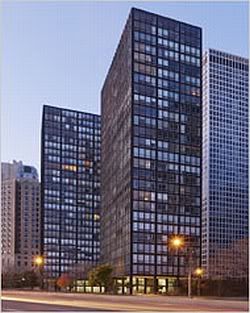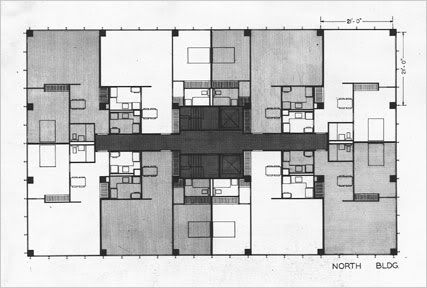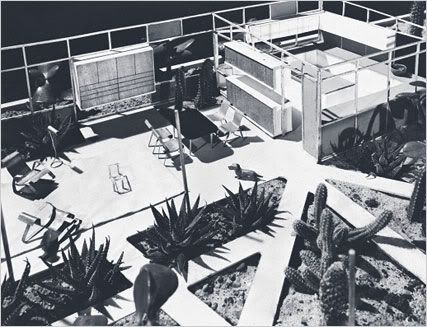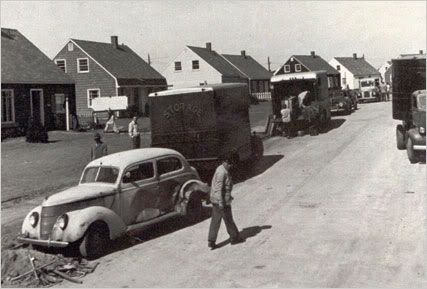| | | |
We tend to think of the decades immediately following World War II as a time of exuberance and growth, with soldiers returning home by the millions, going off to college on the G.I. Bill and lining up at the marriage bureaus. But when it came to their houses, it was a time of common sense and a belief that less truly could be more. During the Depression and the war, Americans had learned to live with less, and that restraint, in combination with the postwar confidence in the future, made small, efficient housing positively stylish. As we find ourselves in an era of diminishing resources, could "less" become "more" again? If so, the mid-20th-century building boom might provide some inspiration. |  William Zbaren William Zbaren
Ludwig Mies van der Rohe designed these towers on Chicago's Lake Shore Drive in the 1940s. They were recently renovated |
Economic austerity was only one of the catalysts for the trend toward efficient living. The phrase "less is more" was actually first popularized by a German, the architect Ludwig Mies van der Rohe, who like other people associated with the Bauhaus emigrated to the United States before World War II and took up posts at American architecture schools. These designers, including Walter Gropius and Marcel Breuer, came to exert enormous influence on the course of American architecture, but none more so than Mies. Mies's signature phrase means that less decoration, properly deployed, has more impact than a lot. Elegance, he believed, did not derive from abundance. Like other modern architects, he employed metal, glass and laminated wood — materials that we take for granted today but that in the 1940s symbolized the future. Mies's sophisticated presentation masked the fact that the spaces he designed were small and efficient, rather than big and often empty. The apartments in the elegant towers Mies built on Chicago's Lake Shore Drive, for example, were smaller — two-bedroom units under 1,000 square feet — than those in their older neighbors along the city's Gold Coast. But they were popular because of their airy glass walls, the views they afforded and the elegance of the buildings' details and proportions, the architectural equivalent of the abstract art so popular at the time. |  Museum of Modern Art. Mies van der Rohe Archive, gift of the architect Museum of Modern Art. Mies van der Rohe Archive, gift of the architect
A Ludwig Mies van der Rohe floor plan for a 860/880 Lake Shore Drive apartment building in Chicago, 1951. | | |
Tom Wolfe's "From Bauhaus to Our House" aside, the trend toward "less" was not entirely foreign. In the 1930s Frank Lloyd Wright started building more modest and efficient houses — usually around 1,200 square feet — than the sprawling two-story ones he had designed in the 1890s and the early 20th century. |  Rapson Architects Rapson Architects
Drawing of a "Case Study House" by Ralph Rapson. | | |
Even the consciously trend-setting Museum of Modern Art promoted restraint in the early postwar years. In 1945, it held an exhibition entitled "Tomorrow's Small House: Models and Plans," and the pioneering model houses that Marcel Breuer and Gregory Ain erected in the museum garden were small and sparsely detailed. The "Case Study Houses" commissioned from talented modern architects by California Arts & Architecture magazine between 1945 and 1962 were yet another homegrown influence on the "less is more" trend. Aesthetic effect came from the landscape, new materials and forthright detailing. In his Case Study House, Ralph Rapson may have mispredicted just how the mechanical revolution would impact everyday life — few American families acquired helicopters, though most eventually got clothes dryers — but his belief that self-sufficiency was both desirable and inevitable was widely shared. |  Rapson Architects Rapson Architects
Model of the interior of a Ralph Rapson "Case Study Home." | | |
"Less is more" wasn't for everyone; modernism was popular mainly with the so-called "Progressives," the professionals and intellectuals who commissioned modern houses. But these trend-setters were not alone in assuming there would be fewer servants in the future and that modern conveniences would make housework easier to do, especially in smaller quarters. |  Levittown Public Library, via Associated Press Levittown Public Library, via Associated Press
New residents moved into their home in Levittown, N.Y. in 1947 | | |
The popularity of simpler living made it possible for one American developer, William Levitt, to realize the prewar dream of the European modern architects to use industrialization for housing. During the war, Levitt had become an expert in mass-producing homes for shipyard workers in Virginia. When it ended, Levitt and his sons created a prototype 750-square-foot, one-floor house—with a living room, kitchen/dining area, two small bedrooms, a bathroom and an unfinished "expansion attic"—to fit on a 60 x 100 foot lot. Set on concrete slabs like those at the shipyards, the new houses were built quickly and cheaply on a sort of assembly line, with pre-cut lumber and nails shipped from the Levitts' factories in California. Eventually, the Levitts built 140,000 houses, clustered in Levittowns on Long Island and near Philadelphia for some of the 16 million returning veterans. In the 1950s, the houses grew slightly, to 800 square feet, and came equipped with carports and built-in 12.5-inch Admiral TVs. Clearly no one considered multiple televisions, or that they would be frequently replaced. The Levittown houses were concentrated on the East Coast, but they influenced suburban development throughout the United States, though elsewhere houses were built manually, as they would be after the postwar building boom. The standard two-bedroom house with an expandable attic became the norm for more than a decade, even as family size mushrooomed. But like much of American society, the middle-class home began to grow over time. The average size of an American house in 1950 was 983 square feet. Slowly, though, both more square footage and more amenities became part of the American dream, so that by 2004 the average home topped 2,300 square feet. What does all that space bring? Small, out-of-the-way bedrooms like those in the Levittown houses' "expandable attics" can be used when children are at home or guests arrive, and the open plan of their main living spaces has become the kitchen/family room that is the center of the American home today. But many of the "must-have" elements in 2010, like formal living and dining rooms, are redundant. In an era of economic austerity and a seemingly permanent energy crisis, can "less is more" become popular again? Sadly, many of the small, architect-designed houses of the postwar period have been demolished to make way for McMansions. But those that remain, and those we know about from blueprints and photographs, have much to teach us — about the efficient use of space for storage, integrated indoor and outdoor space and the way careful design can facilitate natural ventilation. When you think about how many rooms you actually use, it seems obvious that various ideas from that optimistic era could make the next decade a happier, saner one than the overstuffed times we've just lived through. (Note: An earlier version of this article misattributed the origin of the phrase "less is more" to the architect Ludwig Mies van der Rohe. He did not coin the phrase, but adopted and popularized it as an aesthetic maxim.)
| | | Jayne Merkel is an architectural historian and critic. She is the author, most recently, of "Eero Saarinen." She is a contributing editor of Architectural Design/AD magazine and Architectural Record. | | | | |


No comments:
Post a Comment